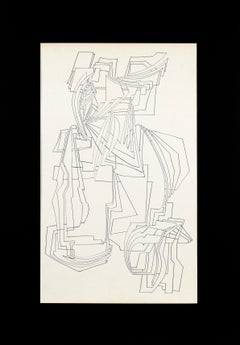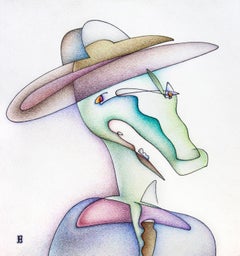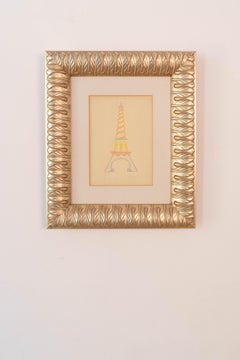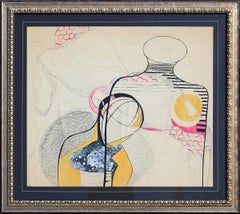Abstract Geometric Figurative Drawings and Watercolors
to
1
3
1
6
3
1
1
1
Overall Height
to
Overall Width
to
4,593
3,255
579
350
276
224
221
213
157
155
60
56
55
47
3
2
2
2
1
2
4
1
1
1
4
4
2
1
1
Style: Abstract Geometric
Abstract Geometric Illusory Line Art in Ink on Paper by Geraldine Heib
Located in Soquel, CA
Abstract Geometric Illusory Line Art in Ink on Paper by Geraldine Heib
In this line abstract by Jerry O'Day (American, 1912), lines intersect and layer in straight and rounded ways giving a sense of movement to the piece. O'Day uses simple ink on paper and pure geometric form in the Minimalist style of the 1960s.
Unsigned, but was acquired with a collection of the artist's work.
Mat size: 39"H x 27"W
Paper size: 30"H x 20"W
Image size: 27"H x 16"W
Jerry O'Day is also known as Geraldine Heib. Born in Oakland, California, on June 17, 1912. Geraldine Heib assumed the name Jerry O'Day at an early age. She grew up in Washington and studied in Seattle at the Cornish School of Fine Arts. Upon moving to the San Francisco Bay area in 1938, she further studied with Bufano as a muralist for two years. O'Day wed sculptor David Lemon and had a gallery in a converted cod fishery in Belvedere from 1942 until 1963. At that time, the couple moved to a houseboat in Sausalito, where she remained until her demise on March 30, 1986.
Post War California artist, Jerry O'Day studied at the Cornish School of Fine Arts in Seattle; studied with Beniamino Bufano for two years. She lived in the artist's colony at the Cod fishery with artist David Lemon on Belvedere Island in the San Francisco Bay Area from 1942 - 1963.
Solo Exhibitions: City of Paris, Rotunda Gallery; Lucien Labaudt Gallery, 1963; Torrance Gallery, San Anselmo, 1955; Marin Art Gallery, Sausalito, 1956; Palace of The Legion of Honor, San Francisco, 1962; East & West Gallery, Fillmore Street, San Francisco; Landmarks Gallery, Marin County, 1991.
Selected Group Exhibitions: 65th Annual Painting and Sculpture Exhibition of the San Francisco Art Association at the San Francisco Museum of Art, 1945; Fourth Winter Invitational, California Palace of The Legion of Honor, San Francisco, 1963.
Source:
David J Carlson...
Category
Mid-20th Century Abstract Geometric Figurative Drawings and Watercolors
Materials
Paper, Ink
Mr. Rabbit, Pen & Colored Pencils Drawing on Paper by Nikolay Starostenko, 2022
Located in Zofingen, AG
Nikolay Starostenko - Mr. Rabbit (2022)
"Mr. Rabbit", Original drawing done in pen and colored pencils, no frame on heavy paper, 34 x 29 cm. The work will be shipped flat and secure...
Category
21st Century and Contemporary Abstract Geometric Figurative Drawings and Watercolors
Materials
Archival Paper, Pen
Carrier Pigeon, Pen and Colored Pencils Drawing on Paper, 2022
Located in Zofingen, AG
Nikolay Starostenko - Carrier Pigeon (2022)
"Carrier Pigeon" drawing is made with a pen and colored pencils on paper.
You can entrust your most important secrets to the carrier pige...
Category
21st Century and Contemporary Abstract Geometric Figurative Drawings and Watercolors
Materials
Pen
Crocodile, Pen and Colored Pencils Drawing on Paper by Nikolay Starostenko, 2022
Located in Zofingen, AG
Nikolay Starostenko - Crocodile (2022)
"Crocodile", drawing with colored pencils and pen on paper, 30x28 cm.
My crocodile is wise and fair, he takes his time with decisions and thin...
Category
21st Century and Contemporary Abstract Geometric Figurative Drawings and Watercolors
Materials
Pen
"Indian Dance", Multicolor Abstract Geometric Composition
Located in Soquel, CA
Bright and colorful abstract geometric watercolor with multicolor connected forms cascading in a dynamic vertical composition by Ellwood Graham (American, 1911-2007). Signed "GRAHAM" in the upper right corner, and "Ellwood Graham" on verso. Circa 1961-1966. The title "Indian Dance...
Category
1960s Abstract Geometric Figurative Drawings and Watercolors
Materials
Paper, Watercolor, Pen, Pencil
Moons of Jupiter (Study I): Black and White Abstract Geometric Graphite Drawing
Located in Hudson, NY
Small abstract geometric drawing of circular white moons on a gray graphite background with grid patterns
“The Moons of Jupiter (Study I)” by Hudson Valley artist, David Dew Bruner,...
Category
2010s Abstract Geometric Figurative Drawings and Watercolors
Materials
Paper, Graphite
Related Items
"Abstract Composition" Watercolor painting 10" x 14" inch by Shaker El Maadawy
Located in Culver City, CA
"Abstract Composition" Watercolor painting 10" x 14" inch by Shaker El Maadawy
signed & dated
Shaker El Maadawy graduated from the Faculty of Fine ...
Category
20th Century Abstract Geometric Figurative Drawings and Watercolors
Materials
Paper, Watercolor
Horse, 2020, gel pen on paper, figurative, drawing, framed, pink, blue, white
Located in Jersey City, NJ
Horse, 2020, gel pen on paper, figurative, drawing, framed, pink, blue, white and green.
Category
2010s Abstract Geometric Figurative Drawings and Watercolors
Materials
Pen, Paper
H 11.5 in W 9 in D 0.5 in
Untitled (Rabbi Scholar)
Located in New York, NY
Seymour Rosenthal (American 1921-2007) "Untitled: Rabbi Scholar", Figurative Pen/Watercolor on Paper signed in bottom right hand corner, 10.50 x 8 (24 x 20.50 In Frame), Late 20th Ce...
Category
Late 20th Century Abstract Geometric Figurative Drawings and Watercolors
Materials
Pen, Watercolor
Untitled
Located in New York, NY
This refined ink on paper work was realized by the renowned American artist Alexander Markovich circa 1985, which the scholar Svetlana Rakic called "The most dispersed and energy-cha...
Category
1980s Abstract Geometric Figurative Drawings and Watercolors
Materials
Ink, Archival Paper
Golf Bags, Caddy with Golf Bag on His Back
Located in Missouri, MO
Framed Size: approx 17 3/4 x 20 3/4 inches
Fred Conway (1900-1973)
"Golf Bags, Caddy with Golf Bag on His Back"
Pen/Ink/Watercolor on Paper
Site Size: approx. 10 x 13 inches
Framed Size: approx. 17 3/4 x 20 3/4 inches
A member of the faculty of the Washington University Art School from 1929 to 1970, Frederick Conway...
Category
1960s Abstract Geometric Figurative Drawings and Watercolors
Materials
Paper, Ink, Watercolor, Pen
The Abduction of the Sabine Women , a Renaissance drawing by Biagio Pupini
Located in PARIS, FR
This vigorous drawing has long been attributed to Polidoro da Caravaggio: The Abduction of the Sabine Women is one of the scenes that Polidoro depicted between 1525 and 1527 on the façade of the Milesi Palazzo in Rome. However, the proximity to another drawing inspired by this same façade, kept at the Ecole des Beaux-Arts, and to other drawings inspired by Polidoro kept at the Musée du Louvre, leads us to propose an attribution to Biagio Pupini, a Bolognese artist whose life remains barely known, despite the abundant number of drawings attributed to him.
1. Biagio Pupini, a Bolognese artist in the light of the Roman Renaissance
The early life of Biagio Pupini, an important figure of the first half of the Cinquecento in Bologna - Vasari mentions him several times - is still poorly known. Neither his date of birth (probably around 1490-1495) nor his training are known. He is said to have been a pupil of Francesco Francia (1450 - 1517) and his name appears for the first time in 1511 in a contract with the painter Bagnacavallo (c. 1484 - 1542) for the frescoes of a church in Faenza. He then collaborated with Girolamo da Carpi, at San Michele in Bosco and at the villa of Belriguardo.
He must have gone to Rome for the first time with Bagnacavallo between 1511 and 1519. There he discovered the art of Raphael, with whom he might have worked, and that of Polidoro da Caravaggio. This first visit, and those that followed, were the occasion for an intense study of ancient and modern art, as illustrated by his abundant graphic production.
Polidoro da Caravaggio had a particular influence on the technique adopted by Pupini. Executed on coloured paper, his drawings generally combine pen, brown ink and wash with abundant highlights of white gouache, as in the drawing presented here.
2. The Abduction of the Sabine Women
Our drawing is an adaptation of a fresco painted between 1525 and 1527 by Polidoro da Caravaggio on the façade of the Milesi Palace in Rome. These painted façades were very famous from the moment they were painted and inspired many artists during their stay in Rome. These frescoes are now very deteriorated and difficult to see, as the palace is in a rather narrow street.
The episode of the abduction of the Sabine women (which appears in the centre of the photo above) is a historical theme that goes back to the origins of Rome and is recounted both by Titus Livius (Ab Urbe condita I,13), by Ovid (Fasti III, 199-228) and by Plutarch (II, Romulus 14-19). After killing his twin brother Romus, Romulus populates the city of Rome by opening it up to refugees and brigands and finds himself with an excess of men. Because of their reputation, none of the inhabitants of the neighbouring cities want to give them their daughters in marriage. The Romans then decide to invite their Sabine neighbours to a great feast during which they slaughter the Sabines and kidnap their daughters.
The engraving made by Giovanni Battista Gallestruzzi (1618 - 1677) around 1656-1658 gives us a good understanding of the Polidoro fresco, allowing us to see how Biagio Pupini reworked the scene to extract this dynamic group.
With a remarkable economy of means, Biagio Pupini takes over the left-hand side of the fresco and depicts in a very dense space two main groups, each consisting of a Roman and a Sabine, completed by a group of three soldiers in the background (which seems to differ quite significantly from Polidoro's composition).
The balance of the drawing is based on a very strongly structured composition. The drawing is organised around a median vertical axis, which runs along both the elbow of the kidnapped Sabine on the left and the foot of her captor, and the two main diagonals, reinforced by four secondary diagonals. This diamond-shaped structure creates an extremely dynamic space, in which centripetal movements (the legs of the Sabine on the right, the arm of the soldier on the back at the top right) and centrifugal movements (the arm of the kidnapper on the left and the legs of the Sabine he is carrying away, the arm of the Sabine on the right) oppose each other, giving the drawing the appearance of a whirlpool around a central point of support situated slightly to the left of the navel of the kidnapper on the right.
3. Polidoro da Caravaggio, and the decorations of Roman palaces
Polidoro da Caravaggio was a paradoxical artist who entered Raphael's (1483 - 1520) workshop at a very young age, when he oversaw the Lodges in the Vatican. Most of his Roman work, which was the peak of his career, has disappeared, as he specialised in facade painting, and yet these paintings, which are eminently visible in urban spaces, have influenced generations of artists who copied them abundantly during their visits to Rome.
Polidoro Caldara was born in Caravaggio around 1495-1500 (the birthplace of Michelangelo Merisi, known as Caravaggio, who was born there in 1571), some forty kilometres east of Milan. According to Vasari, he arrived as a mason on the Vatican's construction site and joined Raphael's workshop around 1517 (at the age of eighteen according to Vasari). This integration would have allowed Polidoro to work not only on the frescoes of the Lodges, but also on some of the frescoes of the Chambers, as well as on the flat of Cardinal Bibiena in the Vatican.
After Raphael's death in 1520, Polidoro worked first with Perin del Vaga before joining forces with Maturino of Florence (1490 - 1528), whom he had also known in Raphael's workshop. Together they specialised in the painting of palace façades. They were to produce some forty façades decorated with grisaille paintings imitating antique bas-reliefs.
The Sack of Rome in 1527, during which his friend Maturino was killed, led Polidoro to flee first to Naples (where he had already stayed in 1523), then to Messina. It was while he was preparing his return to the peninsula that he was murdered by one of his assistants, Tonno Calabrese, in 1543.
In his Vite, Vasari celebrated Polidoro as the greatest façade decorator of his time, noting that "there is no flat, palace, garden or villa in Rome that does not contain a work by Polidoro". Polidoro's facade decorations, most of which have disappeared as they were displayed in the open air, constitute the most important lost chapter of Roman art of the Cinquecento. The few surviving drawings of the painter can, however, give an idea of the original appearance of his murals and show that he was an artist of remarkable and highly original genius.
4. The façade of the Milesi Palace
Giovanni Antonio Milesi, who commissioned this palace, located not far from the Tiber, north of Piazza Navona, was a native of the Bergamo area, like Polidoro, with whom he maintained close friendly ties. Executed in the last years before the Sack of Rome, around 1526-1527, the decoration of Palazzo Milesi is considered Polidoro's greatest decorative success.
An engraving by Ernesto Maccari made at the end of the nineteenth century allows us to understand the general balance of this façade, which was still well preserved at the time. The frescoes were not entirely monochrome, but alternated elements in chiaroscuro simulating marble bas-reliefs and those in ochre simulating bronze and gold vases...
Category
16th Century Abstract Geometric Figurative Drawings and Watercolors
Materials
Ink, Gouache, Pen
Nag Arnoldi , Switzerland - Drawings (1974) : Falling Icarus and Crouching Angel
By Nag Arnoldi
Located in Meinisberg, CH
Nag Arnoldi
(Swiss, * 18.9.1928 Locarno, † 10.2.2017 Lugano)
1. Falling Icarus
• Drawing - Mixed media (Indian ink, coloured pencil & gouache) on paper ca. 22 x 26 cm
• Signiert & ...
Category
Late 20th Century Abstract Geometric Figurative Drawings and Watercolors
Materials
Paper, India Ink, Gouache
Free Shipping
H 8.67 in W 10.24 in D 0.4 in
double-sided marker drawing spanish abstract expressionism
Located in Barcelona, Barcelona
One side signed. Lower right corner slightly bent.
Measures 29x20. Frameless.
Ignacio Gil Sala, was a painter, bohemian character, adventurous and intrepid traveler who knew how to ...
Category
1980s Abstract Geometric Figurative Drawings and Watercolors
Materials
Permanent Marker
Judith Brenner, Sophie Dancing 1, Original Figurative Art, Abstract Sketch Art
Located in Deddington, GB
Judith Brenner
Sophie Dancing 1
Original Figurative Drawing
Acrylic Paint, Pan Pastel, Ink and Watercolour Pencil on Paper
Sheet Size: 84.1cm x W 59.4cm x D 0.1cm
Sold Unframed
Please note that in situ images are purely an indication of how a piece may look.
Sophie Dancing 1 is an original nude drawing by Judith Brenner.The figure is continuously moving and the final work is a composition made in an attempt to capture the rhythm of the dance. This abstract-impressionistic work is evocative of Francis Bacon’s style...
Category
21st Century and Contemporary Abstract Geometric Figurative Drawings and Watercolors
Materials
Paper, Pastel, Ink, Watercolor, Pen
Free Shipping
H 33.12 in W 23.39 in D 0.04 in
Cats Watching a Witch on a Broomstick - Vintage Halloween Illustration in Ink
Located in Soquel, CA
Cats Watching a Witch on a Broomstick - Vintage Halloween Illustration in Ink
Halloween scene with cats and a witch in India ink pen by Irene Pattinson (American, 1909-1999). A blac...
Category
1950s Abstract Geometric Figurative Drawings and Watercolors
Materials
Paper, Watercolor, Pen, India Ink
H 18 in W 20 in D 0.25 in
'Horizon Rise', American Figurative Abstraction, Native American
Located in Santa Cruz, CA
Signed lower right, 'V. Vigil' for Veloy Vigil (American, 1931-1997).
Previously with: Los Robles Gallery, Palo Alto, California
Born in Denver, Colorado,...
Category
1970s Abstract Geometric Figurative Drawings and Watercolors
Materials
Paper, Gouache
Chef Lobster - Vintage Illustration in Ink and Watercolor
Located in Soquel, CA
Chef Lobster - Vintage Illustration in Ink and Watercolor
A charming illustration, by Irene Pattinson (American, 1909-1999), shows a pink lobster behind ...
Category
1950s Abstract Geometric Figurative Drawings and Watercolors
Materials
Watercolor, Paper, India Ink, Pen
H 8.5 in W 11 in D 0.25 in
Previously Available Items
Colourful Eiffel Tower pencil drawing on paper by Paloma Picasso (1972)
By Paloma Picasso
Located in Oostende, BE
Original drawing (with certificate of authenticity) by Paloma Picasso (1949-, Vallauris (Spain)), with a unique frame which amplifies the curly features of the drawing.
Paloma drew...
Category
1970s Abstract Geometric Figurative Drawings and Watercolors
Materials
Paper
"La Jolla" Modern Cubist Yellow, Pink, and Black Figurative Abstract Drawing
Located in Houston, TX
Modern colorful abstract figurative drawing by artist Marta Lek. The work incorporates featureless, cubist style busts with accents of vibrant pinks and yellows. Titled and dated on ...
Category
1960s Abstract Geometric Figurative Drawings and Watercolors
Materials
Watercolor, Gouache, Graphite
H 45.25 in W 51 in D 1.75 in
Andy Burgess, Cinematique, Gouache on Watercolour Paper
By Andy Burgess
Located in London, GB
Gouache on Watercolour Paper
9 x 11 cm
3 1/2 x 4 3/8 in
-----------
Andy Burgess is known for his renditions of modernist and mid-century architecture, panoramic cityscape paintings,...
Category
2010s Abstract Geometric Figurative Drawings and Watercolors
Materials
Paper, Watercolor, Gouache
A Stir of Echoes, paperback cover
Located in Miami, FL
A Stir of Echoes, paperback cover
Murray Tinkelman is a supremely brilliant, underrated and overlooked artist. He constructed complex forms using fine line work and cross hatching. ...
Category
1970s Abstract Geometric Figurative Drawings and Watercolors
Materials
Ink, Gouache
Abstract Geometric figurative drawings and watercolors for sale on 1stDibs.
Find a wide variety of authentic Abstract Geometric figurative drawings and watercolors available for sale on 1stDibs. Works in this style were very popular during the 21st Century and Contemporary, but contemporary artists have continued to produce works inspired by this movement. Many Pop art paintings were created by popular artists on 1stDibs, including David Dew Bruner, Ellwood Graham, and Paloma Picasso. Frequently made by artists working with Paper, and Pen and other materials, all of these pieces for sale are unique and have attracted attention over the years. Not every interior allows for large Abstract Geometric figurative drawings and watercolors, so small editions measuring 8.25 inches across are also available. Prices for figurative drawings and watercolors made by famous or emerging artists can differ depending on medium, time period and other attributes. On 1stDibs, the price for these items starts at $388 and tops out at $6,500, while the average work sells for $860.









